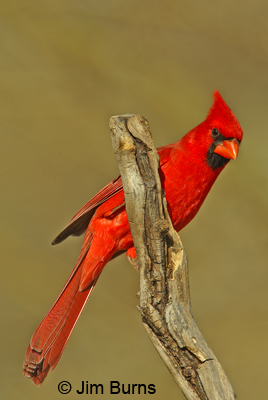
In the East, the northern cardinal, bright scarlet red and conspicuously crested, is so well known and beloved that seven states have chosen it as their state bird. From the plains eastward cardinals are common in woodlots and suburban gardens and, because they are seed eaters, they come readily to feeding stations where they are quite conspicuous.
Here in the Southwest, however, the dense brushy habitat they require for nesting is not plentiful, so northern cardinal is a "local" nester typically found only in desert washes and areas where original desert vegetation has not been bladed for development. Cardinals are often seen mid-town around the Biltmore and in natural suburban settings such as McDowell Mountain Park, the White Tank Mountains, and the recreation areas along the Verde River northeast of the Valley. I can guarantee a northern cardinal sighting at Boyce Thompson Arboretum State Park, just west of the town of Superior, where they are common and confiding. Check especially around the herb garden and the demonstration garden and you should see multiple pairs.
Many birders think our southwestern cardinals are a more brilliant red than their eastern counterpart. Don't forget that cardinals are strongly dimorphic. The females are drab brown but still sport the red bill and the black face which distinguish this species from the gray, crested, desert pyrrhuloxia.
The etymology of our birds' names is often as interesting as the birds themselves. Thus Cardenalis cardenalis, this species' scientific name, comes to us from the Latin for "door hinge," something important upon which a thing turns. The holy cardinals, in importance just one rung below the Pope in the hierarchy of the Catholic Church, wear scarlet robes--cardinal robes--and hence the link from the adjective "cardinal" to the color red and the derivation of the bird's common name.
One winter day in Missouri, while watching birds coming to a seed feeder, I counted 22 male cardinals at one time, a spectacular aggregation not uncommon in the East. You won't find those numbers here in the desert Southwest, unless of course you happen to be at University of Phoenix Stadium on a fall Sunday afternoon where those other Cardinals are starting to feel the love that our scarlet songbird enjoys back East.